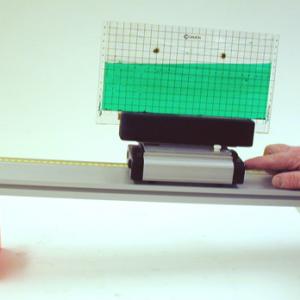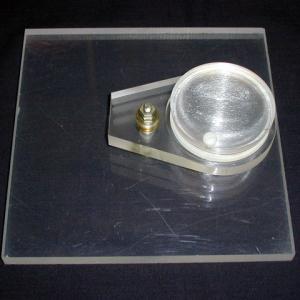College of Liberal Arts & Sciences
1G20.70 - Uniform Acceleration - Liquid Accelerometer & Dynamics Cart
For visible changes in the accelerometer a 200 g weight should be used. HOWEVER: This results in an acceleration sufficient to throw the cart off the track if not caught.
Place one or two 4''x 4'' blocks under one end of the track. Allow the cart with accelerometer to move down the track and notice that the liquid level in the accelerometer is parallel to the track.
The accelerometer in picture three is made for use on the overhead projector. Fill the cavity with water leaving a small air bubble. As you spin this in the overhead, the bubble will go towards the center of rotation and not away from it.
- Said Shakerin, "Improved Centrifugal Effect Demonstration", TPT, Vol. 60, #2, Feb. 2022, p. 84.
- Richard Hake, "Confusing Fictitious Forces?", TPT, Vol. 50, # 8, Nov. 2012, p. 452.
- Philip M. Sadler, Eliza N. Garfield, Alex Tremblay, Daniel J. Sadler, "Inertial Navigation: A Bridge Between Kinematics and Calculus", TPT, Vol. 50, # 2, Feb. 2012, p. 112.
- Héctor A. Múnera, "The Principle of Equivalence: Demonstrations of Local Effective Vertical and Horizontal", TPT, Vol. 48, # 2, Feb. 2010, p. 131.
- Vincente M. Aguilella, Antonio Alcaraz, Patricio Ramirez, "Inward "Centrifugal" Force on a Helium-Filled Balloon: An Illustrative Experiment", TPT, Vol. 40, #4, April 2002, p. 214.
- Robert Ehrlich, "Accelerometers for Use on an Overhead Projector", TPT, Vol. 34, # 4, p. 240- 241, April 1996.
- Virginia Langland, "Acceleration 2¢ Each", TPT, Vol. 32, # 5, May 1994, p. 309.
- Carl Duzen, Jane Nelson, and Jim Nelson, "Classifying Motion", TPT, Vol. 30, # 7, Oct. 1992, p. 414.
- Earl Coombs, "Demonstrating the Difference Between Velocity and Acceleration", TPT, Vol. 28, # 8, Nov. 1990, p. 546.
- D. Easton, "Fletcher's Trolley - Alive and Well", TPT, Vol. 21, # 3, Mar. 1983, p. 184.
- Peter W. Hewson, Sabine Jaunich, and Malcolm H. Moreton, "An Accurate Accelerometer", TPT, Vol. 17, # 1, Jan. 1979, p. 45.
- M. L. Allan, "Keep the Mass Constant", TPT, Vol. 17, # 6, Sept. 1979, p. 406.
- John B. Johnton, "Acceleration a Pendulum", TPT, Vol. 16, # 6, Sept. 1978, p. 404.
- Lawrence E. L'Hote, "Large Scale Use of a Liquid-Surface Accelerometer", TPT, Vol. 13, # 2, Feb. 1975, p. 100.
- J. Harris and A. Ahlgren, "Some Simple Experiments and Demonstrations", TPT, Vol. 4, # 7, Oct. 1966, p. 314.
- Hans Weltin, "Accelerometer", AJP, Vol. 34, #9, Sep. 1966, p. 825.
- Donna Berry Conner, "Which Way is Up?", A Potpourri of Physics Teaching Ideas, p. 13.
- David Kutliroff, "32 - Accelerometers", 101 Classroom Demonstrations and Experiments for Teaching Physics, p. 73.
- John F. Koser, "A Hand-Held, Milk-Carton Accelerometer", Apparatus for Teaching Physics, p. 8, Edited by Karl Mamola.
- "A Simple Accelerometer", The Boy Scientist, p. 229.
- The Project Physics Course - Teachers Resource Book, "Concepts in Motion: D4: Uniform Acceleration Using Liquid Accelerometer", p. 56.
- The Project Physics Course - Teachers Resource Book, "Concepts in Motion: D8: Direction of Acceleration and Velocity & D9: Direction of Velocity and Acceleration - An Air Track Demonstration", p. 58.
- The Project Physics Course - Teachers Resource Book, "Concepts in Motion: Quantitative Work With Liquid Surface Accelerometer", p. 111.
- James Cunningham and Norman Herr, "2. 3. 2. Accelerometer", Hands-On Physics Activities with Real-Life Applications, p. 78.
- Julius Sumner Miller, Q76 & A76, Millergrams I – Some Enchanting Questions for Enquiring Minds, p. 49 & 103.
- Julius Sumner Miller, Q78 & A78, Millergrams I – Some Enchanting Questions for Enquiring Minds, p. 50 & 103.
- Julius Sumner Miller, Q89 & A89, Millergrams I – Some Enchanting Questions for Enquiring Minds, p. 58 & 107.
Disclaimer: These demonstrations are provided only for illustrative use by persons affiliated with The University of Iowa and only under the direction of a trained instructor or physicist. The University of Iowa is not responsible for demonstrations performed by those using their own equipment or who choose to use this reference material for their own purpose. The demonstrations included here are within the public domain and can be found in materials contained in libraries, bookstores, and through electronic sources. Performing all or any portion of any of these demonstrations, with or without revisions not depicted here entails inherent risks. These risks include, without limitation, bodily injury (and possibly death), including risks to health that may be temporary or permanent and that may exacerbate a pre-existing medical condition; and property loss or damage. Anyone performing any part of these demonstrations, even with revisions, knowingly and voluntarily assumes all risks associated with them.


